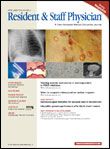A tale of two residents: What eliminating the economic hardship deferment really means
Dear Colleague,
Imagine this scenario, which you may find familiar: two resident physicians live in small apartments in Northeastern metropolitan cities; both carry substantial debt from educational loans but are prohibited from moonlighting to supplement their modest incomes; one qualifies for economic hardship deferment, but the other does not. What effect does this have, and why should it matter to you?
The resident who does not qualify for economic hardship deferment is a first-year anesthesiology resident in New York City. She has two options: make monthly payments of $400 or more on medical school loans or enter into forbearance. Making such high loan repayments is not feasible at this point, and the anesthesiology resident has been forced into forbearance, accruing daily interest on top of her mountain of debt.
does
A surgical resident in Connecticut faces a similar debt burden, but she qualify for an economic hardship deferment under the 20/220 pathway. This allows her to defer loans during training for up to 3 years. Her subsidized loans will not accrue interest during this time, which will save her from accumulating tens-of-thousands of dollars more in debt. In other words, the 800-lb gorilla of debt is still in the room—and growing—but she does not have to feed it yet.
What is the 20/220 pathway?
The current economic hardship deferment criteria, known as the 20/220 pathway, allows residents to defer education loan repayment for up to 3 years during training if (1) they are employed full-time; (2) their federal education debt burden is equal to or greater than 20% of their monthly income; and (3) income minus educational debt burden equals less than 220% of the greater of the minimum wage rate or the federal poverty line for a family of two. Currently, a majority of residents qualify for deferment under this rule.
Unfortunately, the 20/220 rule may soon be replaced with different criteria that will result in very few residents being eligible for economic hardship deferment. This could leave them in the same predicament as our New York anesthesiologist: making high monthly payments or incurring an increasing debt burden because of forbearance.
Why is the 20/220 in peril?
In September 2007, President Bush signed H.R. 2669 into law. This is known as the College Cost Access and Reduction Act, and it did legislate some positive changes to student loan law, such as lowering student loan interest rates and improving Pell grant rules. However, it also eliminated the 20/220 pathway for economic hardship deferment as of October 1, 2007, and the immediacy of this provision caused confusion among lenders and borrowers. The Department of Education used a regulatory maneuver to delay elimination of the 20/220 pathway until October 2008, an action the American Medical Association (AMA) supported.
The AMA continues to pursue a more permanent solution through the Department of Education's regulatory process and via congressional legislation. Senator Richard Burr (R-NC) and multiple members of the House of Representatives have introduced legislation to reinstate the 20/220 rule permanently (S. 2303 and H.R. 4344). As the Higher Education Act is debated, the AMA will ensure that our voices are represented on this issue. While the most intense lobbying efforts have been aimed at restoring the 20/220 rule, the AMA is also advocating expanding the qualifying criteria for economic hardship deferment so that more residents qualify and wants deferment extended beyond 3 years.
Residents and medical students have been instrumental in the victories already scored in this battle, and their contributions will be even more crucial going forward. Over 5,000 e-mails and hundreds of phone calls to Capitol Hill have supplemented the AMA's lobbying efforts. AMA Lobby Day, which took place on March 31, offered residents and their medical student colleagues a great opportunity to employ face-to-face advocacy with members of Congress on these important issues.
It rests in the hands of Congress to preserve the 20/220 pathway and, as advocated by the AMA, expand the hardship deferment criteria so that more residents qualify. Otherwise, it is only a matter of time before the nation's brightest students, contemplating the enormous financial hurdle they would face following medical school, look toward pursuing different careers. Unless these issues receive the attention they deserve, everyone's access to skilled doctors and quality health care in the United States is threatened.
Are you looking for the most up-to-date information on this issue?
Visit www.ama-assn.org.
Brooke Albright, MD
Legislative Advocacy Committee American Medical Association Resident and Fellow Section
Kimberly Ruscher, MD
Governing Council American Medical Association Resident and Fellow Section Delegate
American Medical Association House of Delegates
